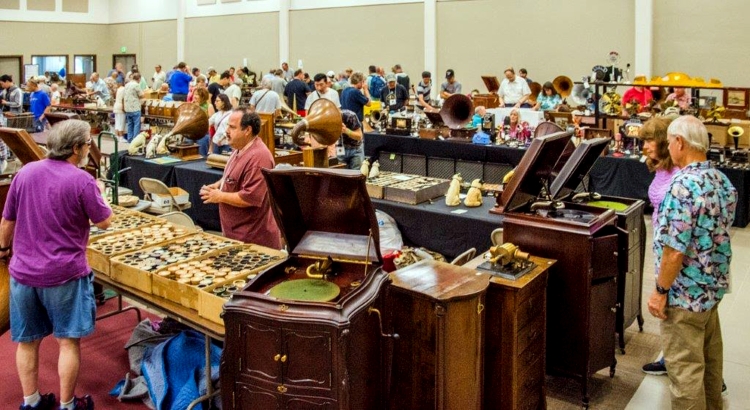Post written by George Paul, Antique Phonograph Society President and co-author of “The Talking Machine: An Illustrated Compendium”
Among those of us who have a serious interest in the history and surviving artifacts of sound recording and reproducing history, there is an elephant in the room. The diversity of collectors and academics often polarizes us into two broad groups: one which regards the other as knuckle-dragging dilettantes, and another group which regards the first as pointy-headed bores. I’d like to make the case for a “big tent” approach which includes a broad-enough scope to satisfy serious collectors/historians of our field as well as practical tips on collecting/repair/enjoyment to benefit those who don’t know a Berliner from a Brunswick. The Antique Phonograph Society is endeavoring to make this “big tent” a reality.
For the typical ARSC member (is there such a thing?), probably the most noteworthy APS achievement in this regard is the searchable online archive. The ever-expanding web site has recently obtained one-half terabyte of storage capacity from a world-class internet service provider and uploaded in excess of 15,000 pages (so far) of documents ranging from January 1890 to the present. Some of these documents consist of primary resources (period articles, original catalogs) while others are articles published in journals around the world from the 1950s to the present on a dizzying variety of topics. The APS was formed in 2011 from the merger of the Michigan Antique Phonograph Society and the California Antique Phonograph Society, and all past issues of their respective publications are included in this archive. There are modern book features by R.J. Wakeman on Brunswick and Sonora – each presenting new research, hundreds of pages in length, and copiously illustrated – as well as historical reprints, like Henry Seymour’s The Reproduction of Sound (1918) and Ogilvie Mitchell’s Talking Machines (1921). Articles are divided into “intermediate,” “advanced,” and “technical” categories to simplify browsing, and new articles and features are added regularly. Members can even view videos of presentations and a large number of interesting talking machines/records in action.
The APS’s Mission Statement and Bylaws (under the “Governance” tab on the home page) will make clear the organization’s primary thrust: education and public awareness. Our 52-page full-color quarterly journal The Antique Phonograph also demonstrates the variety of interests and depth of knowledge of our members. You can view a sample issue on the website. The full text of the journal is searchable in our archive but we’ve also prepared a subject index (for the journal only) if you prefer to browse. I think you’ll be impressed by the breadth of topics (there’s even a “records” section!).
Other APS member activities include development of the CPS1 (“Cylinder Playback System 1” – a device which can play virtually any type/size/speed cylinder record with minimal wear and wide frequency response), restoration of cylinder records, and contribution to the UCSB Cylinder Audio Archive. APS members include Grammy and Oscar winners, descendants of record label founders, jazz recording pioneers and even museums and libraries.
There will always be a wide range of folks who share our field of interest, but if the memberships of ARSC and the APS could be represented as a Venn diagram, I feel certain that a significant portion of each organization would find our interests are shared. ARSC members are encouraged to browse our web site (www.antiquephono.org) and consider joining. The online archive alone is worth the annual dues ($30 in the U.S.).

The 2016 Annual Meeting of the Antique Phonograph Society
